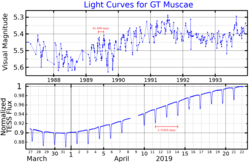 Light curves for GT Muscae. The upper panel (adapted from Murdoch et al. [1] ) shows the long-term variability after a model of the eclipsing binary variability has been removed. The orbital period of HD 101379 is shown in red. The lower panel shows TESS data, [2] in which the eclipses (both primary and secondary) are clearly visible. The orbital period of HD 101380 is shown in red. | |
| Observation data Epoch J2000.0 Equinox J2000.0 | |
|---|---|
| Constellation | Musca |
| Right ascension | 11h 39m 29.56610s [3] |
| Declination | −65° 23′ 52.0995″ [3] |
| Apparent magnitude (V) | 4.96 - 5.23 [4] |
| Characteristics | |
| Spectral type | A: G5/8III+F, B: A0V+A2V [4] |
| Variable type | Algol + RS CVn [5] |
| Astrometry | |
| Proper motion (μ) | RA: −29.762±0.561 [3] mas/yr Dec.: 5.783±0.504 [3] mas/yr |
| Parallax (π) | 8.3972±0.5075 mas [3] |
| Distance | 390 ± 20 ly (119 ± 7 pc) |
| Orbit [6] | |
| Primary | A (HD 101379) |
| Companion | B (HD 101380) |
| Period (P) | 96.8±2.4 yr |
| Semi-major axis (a) | 0.276″ ±0.004″ |
| Eccentricity (e) | 0.634±0.015 |
| Inclination (i) | 60.9±2° |
| Longitude of the node (Ω) | 259.8±1.5° |
| Periastron epoch (T) | 2452778±110 |
| Argument of periastron (ω) (secondary) | 92.4±1.5° |
| Orbit [1] | |
| Primary | Aa |
| Companion | Ab |
| Period (P) | 61.448±0.007 d |
| Periastron epoch (T) | 2444929±6 |
| Argument of periastron (ω) (secondary) | 238±24° |
| Semi-amplitude (K1) (primary) | 12.7±0.2 km/s |
| Orbit [4] | |
| Primary | Ba |
| Companion | Bb |
| Period (P) | 2.75459 d |
| Details [7] | |
| A | |
| Mass | 1.1±0.3 M☉ |
| Radius | 16.6±1 R☉ |
| Luminosity | 126 L☉ |
| Surface gravity (log g) | 1.89±0.05 cgs |
| Temperature | 4,744±125 K |
| Other designations | |
| 12 Muscae, HD 101379, HD 101380, HIP 56862, HR 4492, SAO 251522, WDS J11395-6524AB, [8] B 1705 AB [9] | |
| Database references | |
| SIMBAD | data |
GT Muscae, also known as 12 Muscae, is a variable star about 400 light years from the Earth, in the constellation Musca. [3] It is a 5th magnitude star, so it should be faintly visible to the naked eye of an observer far from city lights. [3] It is a quadruple star system, consisting of a spectroscopic binary containing an RS Canum Venaticorum variable (RS CVn) star (HD 101379), orbiting an eclipsing binary (HD 101380). [1] It varies in brightness from magnitude 4.96 to 5.23. [4] GT Muscae is a very active X-ray source. [10]
In 1929, Willem van den Bos discovered that GT Muscae is a visual double star, whose A (HD 101379) and B (HD 101380) components were separated by 0.2 arc seconds at the time he observed it. [9] Examining photographic plates in 1964, Wolfgang Strohmeier et al. discovered that GT Muscae is a variable star. [11] In 1979, based on spectroscopic features, Edward Weiler and Robert Stencel listed GT Muscae as a likely RS CVn variable. [12] Eclipses of the HD 101380 pair were first reported by Andrew Collier Cameron in his 1982 PhD thesis, in which he also determined that pair's orbital period. [13] The entire star system was given the variable star designation GT Muscae in 1988. [14]
Strong, variable, 5 GHz radio emission from GT Muscae, indicative of flares, was detected in 1982 and was interpreted as indicating high levels of chromospheric and coronal activity. [15]
GT Muscae was detected in the early observations of the Uhuru X-ray satellite, originally denoted as 2U 1134–161, later renamed 4U 1137–65. [16] [17] Michael Garcia et al. identified HD 101379 as the source seen by Uhuru, in 1980. [18] During the 2010-2019 decade, GT Muscae showed the most X-ray flare activity of any star in the sky, producing flares with energies as high as ~1038 ergs. [10]